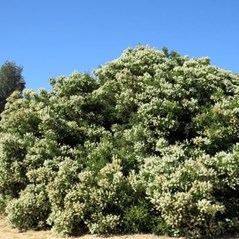Uses: A highly ornamental but hardy small tree. Tolerates coastal exposure and calcareous soils. It can be planted as a shade tree, wind-break or screen. Suitable for wider street verges and nature strips. Attracts nectar eating birds and insects.
Cultural use: Indigenous peoples used nearly every part of this genus in their day-to-day lives. Fibre and bark for clothing and swaddling babies, drinks made from the nectar, wood and stems for implements and to construct shelters.
Note: Fire retardant plant as per SA Country Fire Service, contact for further information.
Note: This species is classified schedule 2, Regulation 24.3 under the
Sewerage Act and may be planted in any street or road in any drainage area provided they are not planted closer than 3.5 metres to any sewer main or connection. They should also not be planted closer than 3.5 metres to any sewer pipe in home gardens.
This plant is indigenous to the following botanical regions of South Australia.
:LE: Lake Eyre
:NU: Nullarbor
:GT: Gairdner-Torrens
:FR: Flinders Rangers
:EA: Eastern
:EP: Eyre Peninsula
:NL: Northern Lofty
:MU: Murray
:YP: Yorke Peninsula
:SL: Southern Lofty
:KI: Kangaroo Island
:SE: South Eastern
For detail on these regions refer to the user guide.
- Canopy Shape Oval
- Height 3-8m
- Spread 3-5m
- Position
- Full Sun
- Part Shade
- Family Myrtaceae
- Botanical Name Melaleuca lanceolata
- Common Name Dryland Tea Tree
- Origin SA, Vic, NSW, Qld
- Habit Spreading canopy, Dense
- Landscape Coast, Coastal footslopes, 2nd line coast, Plains, Footslopes, Hills
- Soil Texture Clay, Loam, Sand
- pH Acidic, Alkaline, Neutral
- Tolerates Drought, Fire, Lime, Moderate frost, Salt spray, Wind
- Supplementary Watering Minimal
- Flower Colour White
- Flowering Time Spring, Summer
- Foliage Dark-green
- Flower Type Bottlebrush
- Purpose Ornamental, Habitat, Wind protection, Screen
- Evergreen/Deciduous Evergreen
- Trunk Rough
- Form Medium Tree (Usually between 5m & 11m)







